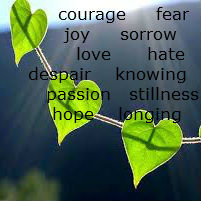For more support and inspiration during tough times, see https://www.facebook.com/krishinesheartinlife?ref=hl
Living with heart
Scroll down for a range of articles, tools and ideas
When we ourselves or our lives or relationships get too messy  we suffer, of course. We become stressed and unhappy and usually struggle to keep it all together. But at some point, eventually, everything begins to be affected. We can see this as a crisis: it may indeed be one. It certainly feels that way. It can also be seen as a life-changing opportunity, once we stop resisting the fact that it’s happening! There is likely to be a part of us saying, ‘But why?? This shouldn’t be happening to me! What’s wrong with me??’ Yet, here it is.
we suffer, of course. We become stressed and unhappy and usually struggle to keep it all together. But at some point, eventually, everything begins to be affected. We can see this as a crisis: it may indeed be one. It certainly feels that way. It can also be seen as a life-changing opportunity, once we stop resisting the fact that it’s happening! There is likely to be a part of us saying, ‘But why?? This shouldn’t be happening to me! What’s wrong with me??’ Yet, here it is.
The Sufis say the wound is the gift. This means that the crisis itself, or the more difficult uneases of life, contain the stuff of healing and change. Real healing and real change. It’s often called rock bottom and tends to be where our’ most profound life learning comes from.
This rock bottom state may be a feeling of desperation, the last straw, the blackest moment, extreme overwhelm, blowing your top, giving up, breaking down, longing, longing for something else. It doesn’t matter where it begins. Something is trying to break through – and as Leonard Cohen says, ‘There is a crack in everything. That’s how the light gets in.So you’re cracked! Well, keep breathing and stay tuned and stay open to where and how the light will get in.
Thus begins the next phase of the process.
If we hang in there, open and questing to discover what we most need from this experience, we can eventually find a way through. This is a time to get support from others you trust and to give yourself support in simple ways throughout your day: pockets of rest, small TLC things that bring pleasure, deflecting self critical thoughts, listening to your gut feelings about who to spend time with and who to avoid, for now.
in there, open and questing to discover what we most need from this experience, we can eventually find a way through. This is a time to get support from others you trust and to give yourself support in simple ways throughout your day: pockets of rest, small TLC things that bring pleasure, deflecting self critical thoughts, listening to your gut feelings about who to spend time with and who to avoid, for now.
If you can keep going, day by day or even hour by hour, giving yourself kindness and respect as you go until the light begins to come, you may find that you are beginning to trust yourself more. You may feel a little hope, a little more possibility.
And through this process, if you are willing to stay present and keep your head 1cm above the storm, a deeper kind of strength and inner knowing comes. In and through the pain, perhaps after many ups and downs, a foundation of well being and happiness can grow which eventually becomes a place to live from and return to after phases of storm and chaos.This all has its own timing, which is usually not nearly soon enough. But it comes. The ups and downs continue, but something internal feels more solid, as if you are at home within yourself.

The poet John O’Donohue gives thanks for “the gift of mind to feel at home in my life.” Mind and heart together are a homecoming team – bringing you home to yourself in all your contradictions and riches; the deepest acceptance therapy.
Some ‘Hows’ for Living with Heart
My approach to living with heart and dealing with life’s messes begins not with assessing and strategising, but with connecting to exactly what’s going on right now – in thoughts, feelings, life events. Now is where the truth begins. What’s present is always the way through. It’s also the access point to what’s next. Slowly, slowly catchee wisdom!
In this series here, I have distilled four steps in this process:
1. Developing awareness or mindfulness – the crucial first step. This can be practiced anywhere, anytime.
2. I OBJECT! Finding the willingness, and dealing with the pain of resistance to what’s happening. Why this? Why me? Ways to process your ‘stuff’ (what’s going on inside you – the compost for your growth).
3. Building the capacity to accept and love who you are and what is going on inside and out, in all its contradictions.
4. Using self knowledge to open up, to make new decisions, to let in new wisdom and new aspects of yourself and life.Thus we begin to live beyond the stories we previously thought were the truth about ourself and life.
Step 1. Simple self awareness (simple idea and not so simple to do, but it’s all about brief moments of practice)
Observe. As you remember, throughout the day, just notice – your thoughts, your feelings, what’s happening in your body, the breeze, what’s going on around you. Pay attention to these without trying to change anything. Notice without judging. If you judge, just notice the judging (which of course will happen, all day long: “I shouldn’t be feeling ,like this” etc) Notice the feelings generated by the judging. Notice how a thought-story about something or someone will take over, often bringing strong feelings with it. Notice the feelings. Notice that you’ve noticed that.
In this way you will begin to develop the habit of the observer, the witness. It is the first step toward self awareness because you are dealing, not with how you want life to be, but to how it actually is as you experience it. It has a feeling of stepping back just a little – not coldly, shutting off, but rather being aware of all you are experiencing – and still connected, yet just a little apart.
Connecting and fully experiencing what’s going on inside is a vital next step, but first we need to develop the observer. So as you go through the day you will be immersed in thoughts, feelings and actions – and then suddenly you will notice this fact and be the observer for an instant. Then back in the stuff of life again. This is just how it works.
For more on mindfulness see the wonderful work of Tara Brach who combines heart and mind beautifully in her approach https://www.facebook.com/tarabrach?fref=ts
Step 2. I OBJECT! Dealing with the pain of resisting what’s happening. Why this?? Why me??
“When we resist change it’s called suffering. But when we can completely let go and not struggle against it, when we can embrace the groundlessness of our situation and relax into it’s dynamic quality, that’s called enlightenment.”
How can we find the willingness to deal with the resistance to things that are going on? How can we deal with our own feelings and process the ‘stuff’ going on inside us? for this stuff actually contains the compost for our growth, the wisdom for our release.
What kinds of thoughts keep you awake at these times? Typical resistance reactions tend to head outwards or inwards:
- Outward reaction: But why???? This should not be happening. It’s not fair! It’s not right.
- Inward reaction: How come other people’s lives are going just fine? What’s wrong with me?
Absolutely!! These are natural reactions to negative, confronting, unexpected, sad and painful events.So it’s no good resisting the resistance. But it drains us and offers no help. And begs the question (thank you Dr Phil!): How is that working for you?
Let’s start with the outward reaction
Somewhere way down, we humans really believe and deeply wish that life should be kind and fair. We want a fair and kind world so much that this can have huge power over our reactions. It means we may get thrown, over and over, when it’s not the way we want. Sometimes deeply thrown. From that point we may blame life, ourselves, God, politicians, the person concerned or those close to us. The problem of suffering – of ourselves and others – is bewildering and has been an eons-old dilemma for our species.
Why? is such a painful question.
This first sudden yet normal reaction locks us into a battle of we are RIGHT and life/them/events or whoever we blame is WRONG. So we quickly move from shock, hurt and disappointment at what’s happening to resentment and anger. If we don’t catch this state in ourselves, it can eventually lead to bitterness and being stuck in the sorrow and hurt which lie beneath that.
How do you deal with the ‘why?’ question?
-
You can’t simply undo a strong negative thought, especially one stemming from a deep inner feeling about life events. You can’t just make it go away! So instead, include that thought by forming it into a statement of resistance and then expanding it into a wider and more powerful statement.
For example, if you feel that people should not do that to each other:
“They should never have done that to me!! People should not do that to each other!! And they did. It is also true that things like that happen all the time on earth. I hate it. And it happens.”
It’s a bit like feel the hate and accept it anyway.
I have two versions of this that help me at these times:
If I’m upset with someone and it’s got to the point of repeatedly arguing with them in my head (way to ruin a good day or a good night’s sleep) I say to myself, “Well, Lynn came here to be Lynn!” ( and not the person I think she should be). This will also help me stop and figure out how to deal with Lynn and with my feelings about her, rather than just stay outraged at her Lynn-ness.
If I’m deeply upset about something that’s happened to myself or another, I might say to myself, “This is so awful, I so wish this wasn’t happening. I feel so sad, angry, helpless … It wouldn’t be like this if I was in charge! Yes, it’s certainly a messy planet and this is what goes on a lot here on Earth. It just does.
These free me to begin to handle my feelings – to understand and process them (perhaps with help from the right person) – which in turn frees me decide what I most need to do about the situation. It still really sucks, but what am I going to do about it? What is within my power to do, and what isn’t?
Next week’s section will deal with the inward reaction: How come other people’s lives are going just fine? What’s wrong with me?
Resilience: tools to handle what life brings

The Tree of Life
“There is a vitality, a life force, an energy, a quickening, which is translated through you into action. And because there is only one you in all time, this expression is unique and if you block it, it will never exist through any other medium and the world will not have it.”
– Martha Graham
Resilience means to recover from misfortune – but recover how?
It also means to bounce back, but bouncy is usually the last way we feel after dealing with a difficult and painful time.
We may feel diminished, and so affected by what has happened that we no longer feel like ‘our old selves’ and fear we will never regain that feeling of being glad to be alive. The SACRED series below looks at steps you can take to better manage your present challenges, recover from the past, begin to heal and eventually thrive again.
Counselling can provide the support to find your way through if you are not managing to do it alone.
The sacred art of resilience
SACRED: worthy of respect and awe. All lives and the people who live them are unique, valuable and extraordinary in their own way. Resilience begins with honouring yourself as you are now, and your life as it is.
I have used SACRED as an acronym for Self Honesty, Acceptance, Compassion, Recognising Needs, Empowerment and Decisive Action – all tools which help tremendously in dealing with challenging events, dark thoughts and feelings and unhappy times.
PART 1: SELF HONESTY – Questions and considerations about being really honest with yourself
This kind of honesty can be painful, but it is very freeing and empowering.
Ask yourself:
– What’s going on in this situation? What thoughts am I having? What am I experiencing and feeling about myself? About the situation? About the others involved? What’s working and what’s not working?
– Who is actually responsible for my feelings?
– What effect is this having on me? On others? Is my pusher, pleaser, perfectionist or inner critic running things? Am I beating myself up? If so, is that helping?
– What are my habitual ways of reacting? How are they helping or not helping?
– What am I making this mean? E.g. Am I having unhelpful thoughts, like catastrophising, mind reading, personalising, black and white thinking, shoulds, musts, always/never thinking? Am I believing false beliefs like “I can’t handle this” or, “Everyone else has their lives sorted but there’s something wrong with me?” (See cognitive behaviour therapy)
– Which part of the situation is my business? Which is theirs? You can ask or appeal, but you can’t control their part.
– Am I bringing unresolved past issues and feelings to this situation that don’t belong there and that I could actually resolve? What do I need to do to heal those feelings? Healing brings relief, inner strength, and new hope and energy.

When we stop resisting and accept 100% that this is the way it is right now, it’s as if the world stops. We are now free to begin again to deal with our situation in a clear and empowered way.
“On the acknowledgement of what is, is the ending of all suffering.” – Krishnamurti
PART 2: ACCEPTANCE
Acceptance does not mean you have to condone or feel ok about something or someone. It means that you accept that it did indeed happen. And perhaps continues to happen. It’s simply a fact; the story so far.
However, learning the art of acceptance will free you from extraordinary amounts of suffering.
If happiness is an inside job, then acceptance is the master key.
- Here and now – this is the way it is at the moment. “If it’s raining, chose rain.” Resistance is painful, tiring and futile.
- Worrying happens automatically, but is exhausting and achieves nothing. Learn to distinguish worrying from constructive and useful thinking and planning. Change what you can and accept what you can’t – it’s worth it!
– Acceptance frees and empowers us to deal with what life brings, to recover, learn and thrive.
– Acceptance includes acknowledging that you wish this wasn’t happening and allowing your feelings about it.
- Where are you putting your energy and is this helping? Are you judging yourself, comparing yourself unfavourably with others? Are you stuck in resentment? That may be understandable, but it is also painful, tiring and futile.
- Accept how you are coping so far, without blame or guilt. Allow yourself to be human with a mix of abilities and fallibilities, like everyone else. And remember – you are not your problems. Life is happening; be in it but not of it.
PART 3: COMPASSION

Instead of suffering at the mercy of our self-critical thoughts, with awareness and practice we can learn to give ourselves the unconditional love, compassion and nurturing that we wanted from our parents. Life feels very different from this place. A kind of softening and blossoming can happen.
In order to extend compassion to yourself – to even begin to feel that you really are ok just as you are – you will need to ‘separate’ from that self-critical voice, or self, we call the inner critic. Separating, in voice dialogue , means to firstly become as aware as you can of the thoughts, values, energy and presence in the body, feeling and perspective of your inner critic. And secondly, to move it aside, as it were, and detach from it. Not get rid of it or try to suppress it, but rather to use your mindfulness and awareness to recognise its presence when it is active, and realise it is simply a tape, an energy system that runs on automatic, but it’s not who you are.
While you’re on the way to practising this awareness and recognition of your inner critic (and other selves that have strict rules as to how we should be in life), the exercise below will help you both to de-stress and to develop compassion towards yourself, as an attitude, a practice, and an actual experience of love.
Awareness, mindfulness and compassion exercise
First find a quiet, comfortable spot where you won’t be disturbed for 15 minutes minimun. And turn off the phones.
In this moment, be aware of thoughts that arise. Notice any judgmental thoughts, accept them all, let them just be there, then let them go. They are just habits, they arise. You don’t have to entertain them or believe them. Let them float off. When they reappear – as they will – just notice them and let them go again.
Now connect with how you are feeling in this moment – paying attention to your body feelings and emotional feelings as they are present in the body, rather than to thoughts, or the stories about the emotions. Let all the feelings that arise be there, just as they are. Breathe into them, by imagining your breath flowing gently to where any feelings or body tension are, without trying to change anything. Connect consciously with your whole self, just as it is, just as you are.
Now send yourself the Love Wave, by imagining a warm, soft wave of compassion flowing slowly down from above your head, through your head and face, down your back, through your whole body and out through your arms and legs. Let it flow through every bone, muscle and organ, your skin, through every cell. As your breath flows in and out naturally, let this love wave also flow through your mind and thoughts – all of you.
As the wave flows through you, allow every part of you to soften and let it in. If parts of you feel tense, or hard and resistant, just let that tension or resistance be there too and become part of the love wave, just as a tree has both hardness and fluidity, just as both water and rock have their place.
Use the feeling and softness of this wave to be fully present with yourself now, in that moment. Acknowledge yourself: you are OK just as you are. Let the love in.
PART 4: RECOGNISING NEEDS – a fast way to greater happiness and well-being
Some of us are very independent and automatically handle things by ourselves, the way we have always done. Often this leads us to ignore important personal needs; we may not even realise they are there! This means we may be settling for habitual levels of stress and dissatisfaction, and less of the things that would make a positive difference.
What needs? you may ask. Well, they’re unique to all of us – but some commonly ignored needs are:
good company, relaxation, emotional support, fun, connection with others, feeling valued and respected, sleep, newness, feeling like you belong, knowing you are making a contribution, greater financial security, spiritual connectedness with ourselves and others,
Want a well-being change?
Develop the habit of asking the magic question: what do I need right now?
Tune into both your inner needs (e.g. to centre, take a deep breath, stop and think) and the outer ones (e.g. talk things out with someone, think of creative solutions) and find, for now, the simplest way to attend to these needs.
Ask yourself: what is needed to deal best with this situation?
Get creative, be flexible and also open to new possible ideas and solutions. Where do you need help, more information, professional input or clarification? How can you plan for that?
Make a plan to handle things well if they don’t change. Debrief frustration and disappointment with a good friend.
Ask yourself: what experience do I want to be having (eg peace, feeling respected, happiness) and how can I feel that now, in some way? Look for small in-the-moment things that will make a diffference.
Pay special attention to two inner ‘voices‘ (or kinds of self talk): your Inner Critic, who can make you feel very miserable if you don’t catch it; and your Judge, the part of you who rigidly judges others and can leave you stuck in resentment. Their information maybe useful at times, but they don’t themselves have solutions that help you deal positively with yourself or the situation. If you become aware that these voices are running you, step back to a more neutral, aware place and look at things from there. Click here for more information on awareness and inner voices.
The next section of Resilience on Empowerment will be posted soon.



